Caleb Cain Marcus’ Photos of Glaciers on a Disappearing Horizon
With a surprisingly light touch, the New York City-based photographer instills feelings of solitude in his images of massive glaciers
/https://tf-cmsv2-smithsonianmag-media.s3.amazonaws.com/filer/20130321124024Perito-Moreno-Plate-I-small.jpg)
What happens when you lose your grip on the horizon? How much does it warp your sense of scale? One trek on the 97-square-mile Perito Moreno glacier in Patagonia and Caleb Cain Marcus was hooked by these questions of perspective. With that experience, in January 2010, the New York City-based photographer launched a two-year odyssey, documenting, in his own minimalist style, glaciers all around the world—in Iceland, Alaska, New Zealand and Norway.
Marcus shares 3o photographs taken in his travels in his latest book, A Portrait of Ice. The images—three of which were recently acquired by the Metropolitan Museum of Art—are “eerily gorgeous and unusual,” writes Marvin Heiferman, a known critic and curator, in an essay featured in the book. “Instead of picturing monumental walls of ice that advance over and disrupt what lies beneath, or icebergs that break away from glaciers to float majestically, if threateningly, at sea, these photographs suggest that glaciers cover the earth’s surface lightly, like a sheet, rather than bearing down upon it,” he adds. The comparison that Heiferman makes later in the essay is compelling: “The jagged rocks, ridges and pinnacles that poke through the frigid surfaces don’t register as being particularly dangerous, but more like the eccentrically rendered landforms you might soar over in a dream or in the elegant flight-simulation of a video game.”
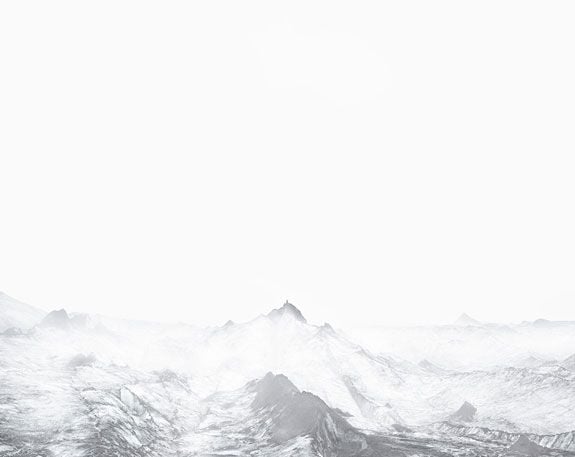
Intrigued, I recently had the opportunity to interview Marcus by phone. We discussed some of the thoughts driving the project and his process:
When you exhibit the series, you like the photographs to measure 43 inches by 54 inches. Why do you like to work in this large-scale format?
Obviously, the glaciers themselves are quite large. I think it is easier to get immersed in something when it is large. I think small makes things potentially more intimate. If it is small, you are required to go up close to it and inspect it. If it is large, you can sort of be overwhelmed by it.
What inspired your initial trip to Perito Moreno glacier in Patagonia?
I was visiting someone in Buenos Aires, and then we took a side trip and flew outside of El Calafate, which is a small town in Patagonia. Near El Calafate was Perito Moreno. It seemed like a good opportunity to go and visit a glacier. I grew up in Colorado, and I have a love for the mountains and open space, which I don’t get much of in New York.
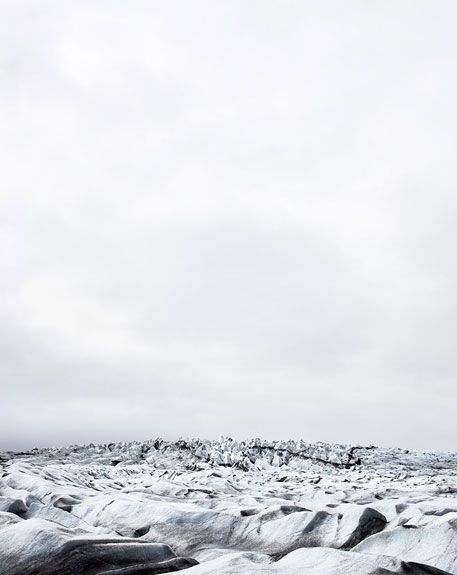
How did you explore the glacier? What did you get to do?
I just hiked around on it. Many glaciers are covered with snow, so you don’t really see them as glaciers as much, at least I don’t, because you are not seeing the ice. You are seeing the snow, which is layering on top of the ice. This was probably the first hard-ice glacier I was on.
What was it about the experience and the photographs that you shot that really inspired you to spend the next two years photographing glaciers around the world?
The ice landscape was certainly one that I hadn’t visited before. I think that many people never really get a chance to visit it or never choose to visit it. Most of us have seen some form of a desert and a forest and an ocean, but we haven’t really just seen ice. It is quite a different ecosystem, and one that fascinates me quite a bit. Everything is so open and so expansive. I think it was that feeling of expanse and emptiness and solitude, on a personal level, that made me want to be there.
When I took the pictures, I had this idea to try to see what would happen if the horizon disappeared. Living in New York City, unless you live very high up, you never see the horizon, which is really kind of odd and something that took me a few years to realize. You are missing that. It is such a grounding presence for people to be able to see the horizon. I’m not sure we are really aware of the effects of not being able to see it. I thought, okay, if I get rid of the horizon or I try to, how is that going to affect the feeling of the picture? You lose a sense of scale.
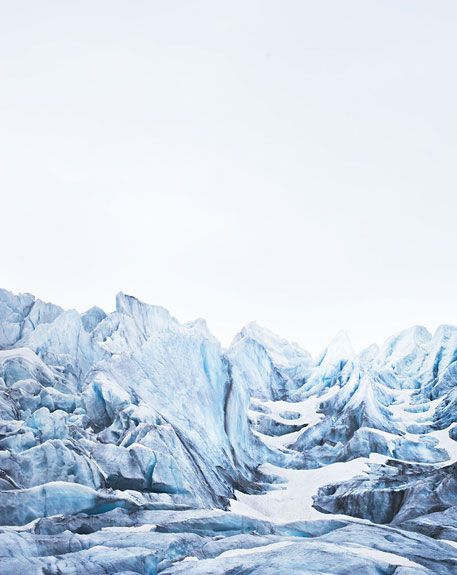
Many of the images are vertical, with mostly sky and then the surface of the glacier occupying just a small portion at the bottom. Why did you choose to compose them this way?
I think there are three general options. One would be that you would have about half glacier and half sky. I think that would be too balanced. Then, you could have much more glacier than sky, which would work, but it would produce something that is much denser. I didn’t really feel like the glaciers were so dense or so heavy, even though they are so massive. I wanted to create a feeling of more openness; I think if you have more sky than glacier that helps to do it. It helps to make it float a little more. Having just this small amount of density of color at the bottom, contrasted by that wide open space, also creates a balance in a way. Because the sky is more empty, they still sort of take up equal weight on the image.
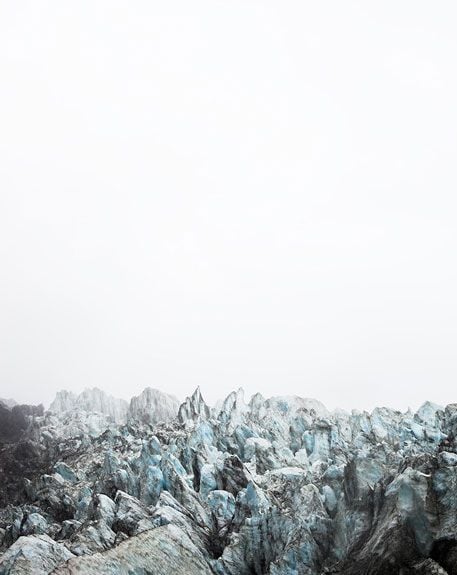
Do you want the viewer to lose perspective?
I would say probably most people looking at it wouldn’t realize that there is no horizon—at least, not consciously. But I think that one of the things it does is it makes it feel less familiar. When something is less familiar, then we look at it more closely, instead of just glancing at it and saying, “Oh, I know what that is. It is a glacier, or that’s a tree or a person or an apartment building.” If it has a little bit of a twist, then I think people spend a little more time or there is a little more examining. Maybe there is more potential that there is some effect on them, which would be ideal.
How did you think about color?
In terms of the colors of the glaciers, whether they are blue or gray or more cyan, I didn’t have too much choice. I was looking for the glaciers with more color. There are a few that are almost black and white, which are in Iceland. That was after the volcano erupted a couple of years ago, so those have the mist and the ash from the volcano. It doesn’t give it an intense color, it is giving it a very subtle color.
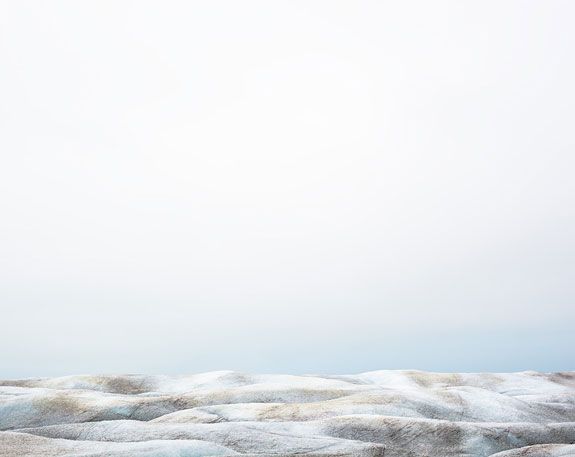
Did you have certain criteria for the glaciers and locations that you picked?
That was one of the challenging aspects. You never really knew what you would get. I would look at topographic images and satellite images. I would talk to other climbers and get a general sense of what a glacier I was going to might look like. But whenever I got there, it was all a surprise.
I was looking for texture and color, so that they had some kind of resonance, some personality. In the book, there are nine different glaciers. I probably went to more than 20 glaciers, so only a small number of them are represented. The other ones, either I wasn’t on the ball or else the glacier wasn’t on the ball. Somehow the communication between the two of us didn’t work out.
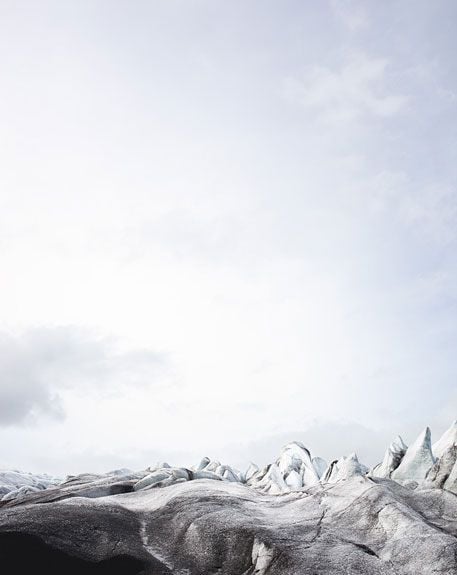
I imagine there were a bunch of logistics that went into these trips.
In terms of getting to the glaciers, pretty much all of them required a hike. I kayaked into some of them and took a helicopter once or twice. Most of the time I had a guide. Of course, the guides are there to find access to the glacier and then also as a safety measure or policy. In that regard, they want to make sure that you come back in one piece, which is a good thing, but it also means that they always try to keep reins on you. I don’t like having someone holding me back. I am always running around, and they are always yelling at me. It would usually take a few days for our relationship to sort of coalesce into something smoother. There would be some friction in the beginning. Then, after a few days, we would have a better understanding of each other.
The guides were quite resourceful in terms of their information. I actually met with a few scientists on various glaciers. In Norway, I met with a couple of them measuring the speed of the flow of the glacier. So, I would always take the opportunity to talk to them.
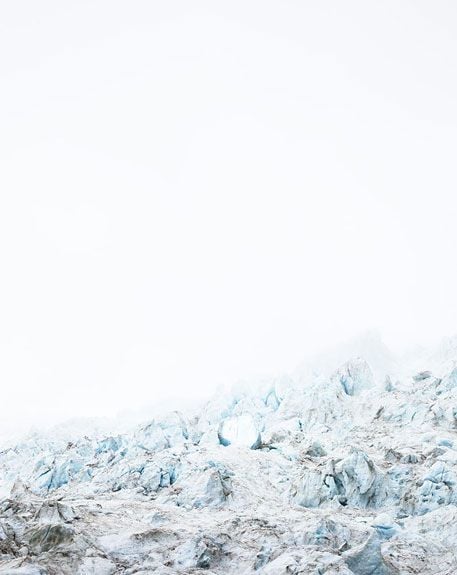
In your own essay in A Portrait of Ice, you write, “The Inuit elders say the melting of the ice is the land crying out in pain. Now we must listen.” The statement implies an activism on your part. Is that one of your intentions? Do you want viewers to care more about the environment and about the melting of glaciers?
I think photographing glaciers I was pretty aware that even if there wasn’t too much of that sentiment that it would be there in the background. I feel very close to the earth or however one wants to term it. I think that we have more than half of the people living in cities now in the U.S. With that, we are losing an awareness for the natural environment. Whether these bring people closer to the environment or not, I don’t really know. I certainly think that if people were more connected to it, that they would act differently in their lives. A lot of the people who make decisions on a high level are, I think, even more detached because they are so immersed in running corporations or in making more money. I think that the planet suffers because of that, and so do we.
These images are excerpted from the book, A Portrait of Ice, published by Damiani.
/https://tf-cmsv2-smithsonianmag-media.s3.amazonaws.com/accounts/headshot/megan.png)
/https://tf-cmsv2-smithsonianmag-media.s3.amazonaws.com/accounts/headshot/megan.png)